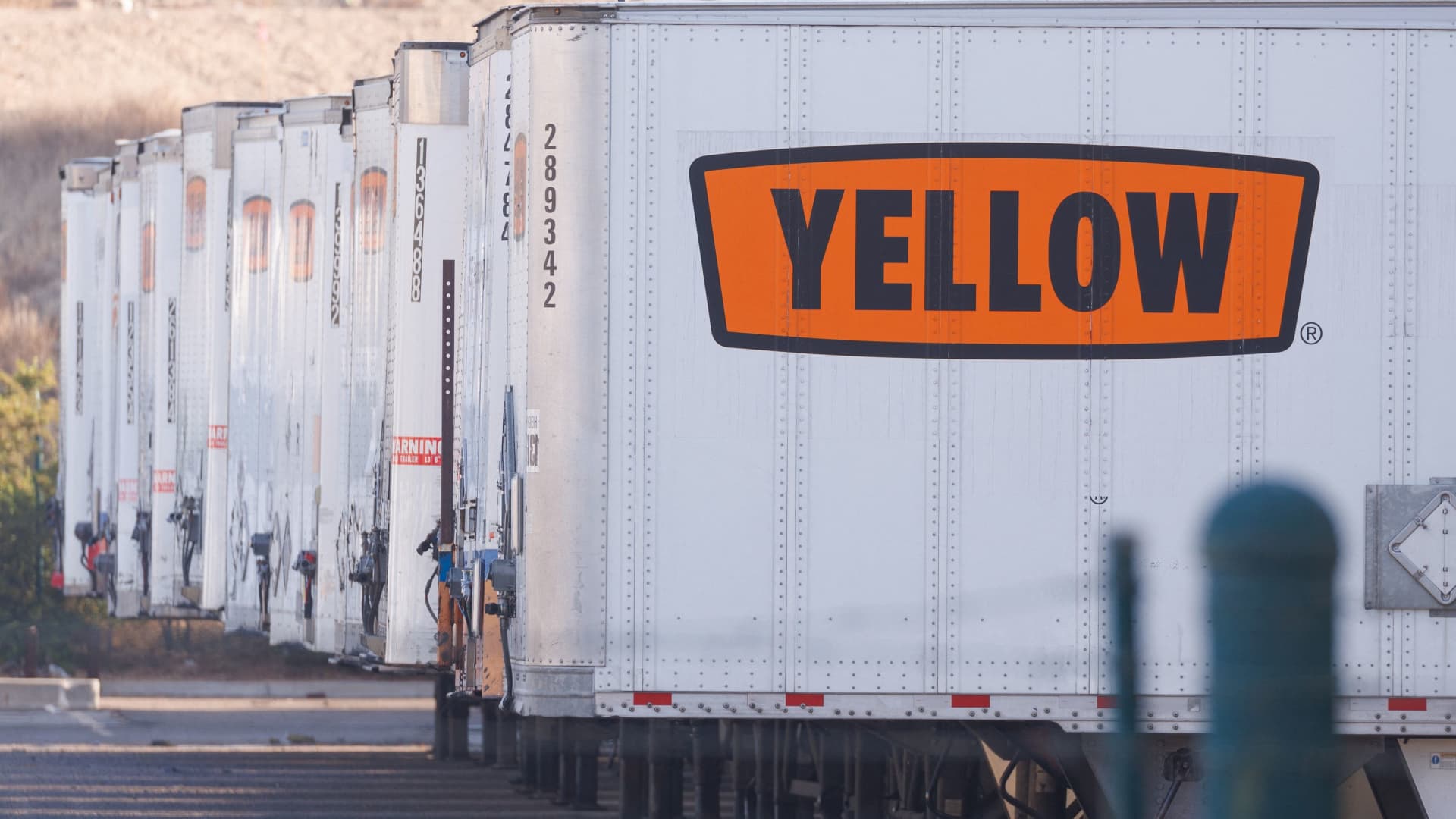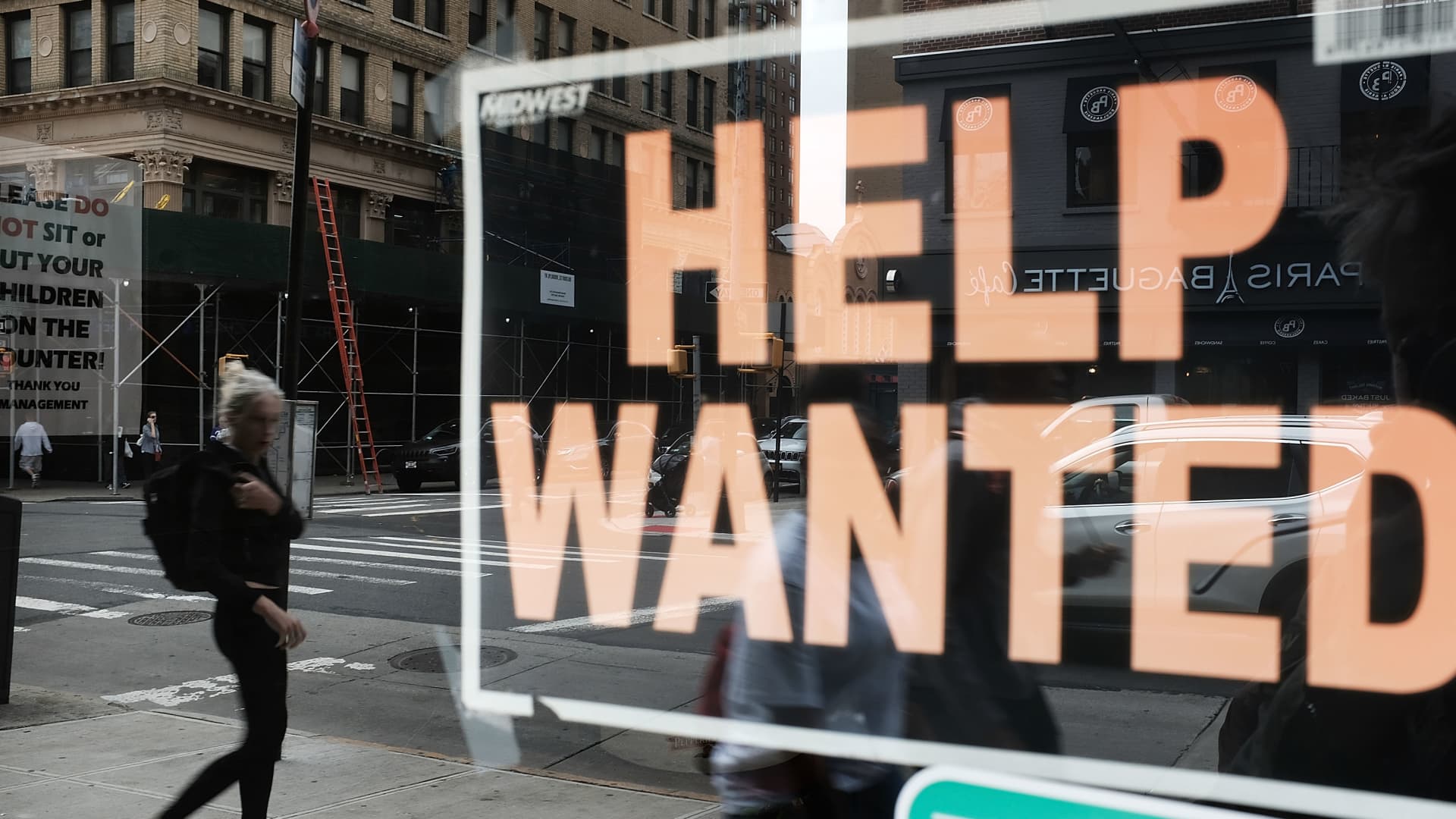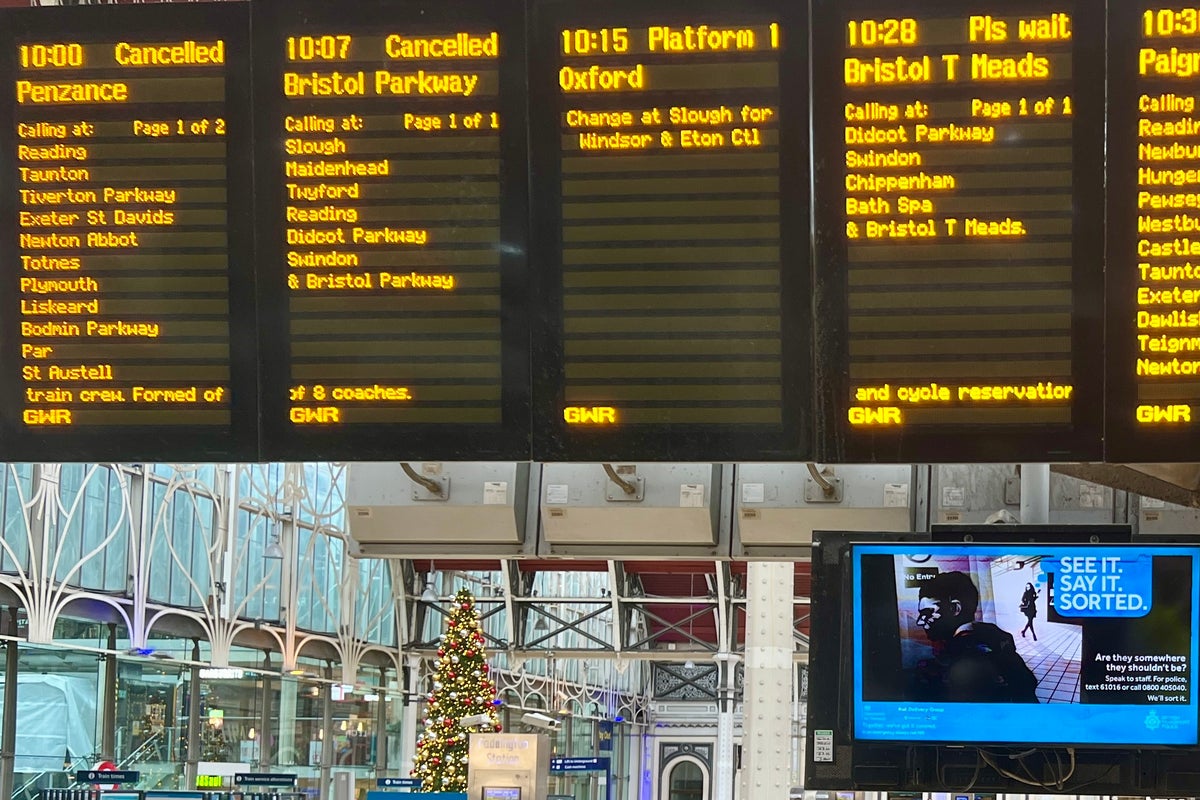What the billion-dollar battle over bankrupt freight company Yellow means to truckers and the economy
Bankrupt trucking company Yellow turned down a billion-dollar bid to resurrect its operations, but the blow is more to the individual trucker than the economy.

Semi truck trailers are pictured at freight trucking company Yellow’s terminal near the Otay Mesa border crossing between the U.S. and Mexico, after the company filed for bankruptcy protection, in San Diego, California, August 7, 2023
Mike Blake | Reuters
A group of investors hoping to salvage shuttered trucking giant Yellow (formerly YRC) were dealt a setback on Thursday when executives from the bankrupt company turned down a billion-dollar bid that would have scooped up much of what was left. But the group of investors led by trucking executive Sarah Riggs Amico vowed to continue, hoping that in the end the courts and the Treasury Department allow them to prevail.
One of the sticking points has been Amico's request to restructure a $700 million CARES Act loan repayment, which helped keep the trucking giant afloat during the pandemic. The U.S. Department of Treasury says their hands are tied.
"The loan in question was made during the prior Administration, and Treasury is one of several creditors taking part in the bankruptcy process. We will continue to work to ensure taxpayers, and impacted workers and their families are treated fairly." Ashley Schapitl, Treasury Spokesperson, told CNBC.
Other Treasury officials have said the loan cannot be modified because Yellow is in bankruptcy and that new Congressional authority would be needed to issue a new loan since the CARES Act authority has expired. Yellow's would-be rescuers are disputing Treasury's legal opinion.
A bipartisan group of eight senators, including Sen. Josh Hawley, R-Mo, and Elizabeth Warren, D-Ma, have publicly supported attempts to save Yellow and its 30,000 jobs, pressing Treasury to restructure the loan.
What brought the iconic freight company to the brink
Yellow, formerly YRC Worldwide, was an iconic presence on America's highways for generations until its sudden shuttering in July. Six months and a Chapter 11 filing later, it's clear that there are many shades of Yellow. Some see the yellow of a fading sunset, while others see the bright yellow of a new beginning. Still, more entities – like the government and creditors – are caught in the middle.
When Yellow ceased operations, it left 12,000 trucks and 35,000 trailers idle, which could form the foundation for a new business. Yellow traces its roots to a taxi service in Oklahoma by the same name that started in the 1920s.
For generations, Yellow grew into a freight giant that touched almost every corner of the American economy, becoming one of the top 10 freight carriers in the country, grossing over $6 billion in 2022.
But a series of corporate events, from mismanagement to malfeasance, took the company to the brink. When Covid-19 caused the nation's supply chain to grind to a halt, Yellow received the $700 million lifeline loan through the CARES Act. Even that, though, wasn't enough.
Experts say many of the dire predictions of snarled supply chains and higher freight prices in Yellow's absence have yet to materialize.
"There are a lot of implications to individuals, but to the industry and industry segment, I don't see anything significant," said Michael Belzer, a professor of economics at Wayne State University. Before entering academia, Belzer spent 12 years as an OTR driver.
"In a macro-sense, one company goes down, other companies rise up and take their freight," Belzer said.
How truckers' lives have been disrupted
Drivers walk to their trucks while working at YRC Worldwide Inc. in Carlstadt, New Jersey, U.S., on Thursday, Dec. 31, 2009. YRC Worldwide Inc. bondholders agreed to swap their debt for equity in the largest U.S. trucker, enabling the company to avoid a bankruptcy filing that may have resulted in liquidation. Photographer: Jin Lee/Bloomberg via Getty Images
Bloomberg | Bloomberg | Getty Images
Investors hoping to revive Yellow say that the market hasn't recovered and the well-paying union jobs that Yellow truckers occupied have left a void in the economy.
Nathan Skobodas worked for five years as an operations manager at a YRC terminal in Grand Rapids and says former coworkers have had difficulty.
"Some coworkers I have kept in touch with have not found similar placement and have taken pay decreases," Skobodas said.
Many others have had their lives disrupted.
Kenneth Cantley, of Rosemont, Minnesota, spent nine years driving for Yellow until he got injured on the job, so he had to leave his position and started collecting workers' compensation just before the company shut its doors.
"It really messed things up for a while," Cantley said.
His worker's compensation payments quit coming, and for eight weeks, he was without any income until the official bankruptcy was filed, and that is when the payments resumed.
"I struggled without any weekly income," Cantley said.
Yellow Trucking offered "competitive" pay and a stable, safe job for new truckers, said Bradley Maroon, assistant director of Hamrick Truck Driving School in Ohio. He says the union jobs at Yellow offered new truckers protection and advocacy.
"And Yellow was the only trucking company I know of where the truckers never had to sleep in their trucks; they would always put them up in a hotel room, which is a pretty big thing," Maroon said.
Overnight trips, though, were a relative rarity for Yellow drivers, which made their jobs sought after by truckers who didn't want to be gone for days at a time.
The importance of the less-than-truckload market
Yellow Trucking inhabited a niche segment of the trucking market known as less-than-truckload (LTL). The margins are small, and LTL trucking touches every aspect of people's lives, whether they realize it or not.
"The diversity of the customers in LTL is what makes it different; with LTL, you'll deliver to homes, hospitals, and barber shops; you don't have the same customers every single day; every day is a new day totally different than the next," said Nick Burlingame, school director and certified CDL instructor for Sage Schools in New York.
While LTL has variety and same-day hauls, which makes it appealing for a driver not wanting to be gone for days, OTR involves days on the road. Burlingame said that LTL requires a particular subset of drivers who are okay with cramming their big rigs into tight spaces like urban alleyways or small parking lots.
High shipping costs in Yellow's absence have yet to materialize, says Ken Vieth, president of ACT Research, which monitors the freight market. Vieth says LTL rates did increase since Yellow's closing, jumping 4.4 percent month over month in August and another .09 percent in September, but Vieth says the increase was mostly likely related to a 49-cent gallon jump in diesel prices from July to August, followed by a 19 cent rise from August to September. Regular gasoline and diesel prices have retreated since October.
The bankruptcy also came amid a freight recession which has pressured the business models for many players in the trucking space and led to multiple rounds of layoffs and failures.
"No one is missing Yellow," Vieth said. "They went out of business at the bottom of a freight cycle when there was considerable industry overcapacity."
In fact, Yellow's exiting the market actually helped the LTL sector.
"With Yellow's demise, the LTL portion of the market went from loose to snug in a weekend," Vieth said. With the weakest market participant and roughly 10% of LTL market capacity shutting down, the publicly traded LTL carriers (as a group) saw their second-best ever profitability quarter in the third quarter.
According to data provided by Tank Transport to CNBC in November, rising fuel costs and falling freight rates had caused a total of 31,278 trucking companies to either close or shift their services to larger fleets.
Freightwaves reports that the biggest beneficiary of Yellow's freight is Georgia-based LTL carrier Saia, which saw an 11 percent uptick in business in the third quarter.
Burlingame concurs that the market has been able to absorb Yellow's demise. And with a driver shortage plaguing the industry, Burlingame says that even if drivers are moving into non-union jobs, they still usually have strong protections.
"In today's market with the driver shortage almost all of these companies are treating these drivers well with good pay and health benefits, they have to if they want to keep them," Burlingame says.
ATLANTA, GA - NOVEMBER 02: Georgia Democratic candidate for Lt. Governor Sarah Riggs Amico addresses the crowd gathered for a campaign rally at Morehouse College on November 2, 2018 in Atlanta, Georgia. Former US President Barack Obama joins Georgia Gubernatorial Democratic candidate Stacey Abrams during a campaign stop. (Photo by Jessica McGowan/Getty Images)
Jessica Mcgowan | Getty Images News | Getty Images
Sarah Riggs Amico disagrees with that assessment, which is why she and a group of investors are attempting the last-ditch effort to resurrect Yellow, but even that is semantically incorrect. If Amico's bid is accepted, the new company will be called Next Century Logistics. Amico is currently President of Jack Cooper Trucking, which specializes in hauling automobiles.
The Yellow brand may be tarred, but the business isn't, according to Amico.
"The business was fundamentally fixable and still is," Amico said. Amico grew up in a trucking family and has rescued struggling trucking firms before. Amico says for her, the issue comes down to jobs. But a Treasury official said on background that Amico's bid would only bring back half the lost jobs. Many former Yellow terminals also have also been sold in auction as the bankruptcy process progresses.
"An LTL carrier without a network of terminals cannot exist," Vieth said.
Amico, however, who ran unsuccessfully for a Georgia Senate seat in 2020, has been working with the Teamsters, who blasted the Yellow bankruptcy and government loan issues, to get some sort of a deal approved.
"Literally, the No.1 most important thing is the jobs," Amico says.
The Teamsters did not respond to a request for comment.
For Amico and her investors to succeed with their proposed billion-dollar rescue package, they must navigate a complex web of auctions, regulations, and garner court and government approval, which remains far from certain. There are still outstanding questions from Yellow's creditors that are an impediment to moving forward. The terms of the deal mean that private equity and asset managers will end up with the bulk of Yellow's assets leaving Treasury, employees, and other claimants with little collateral.
As more Yellow assets are snapped up in auctions, though, any revived LTL business will be far smaller. For Amico, however, some jobs salvaged are better than none.

 MikeTyes
MikeTyes 
































